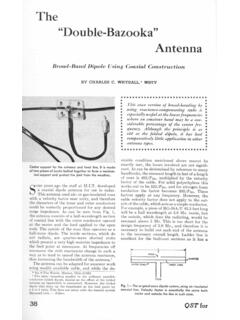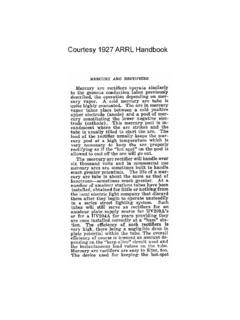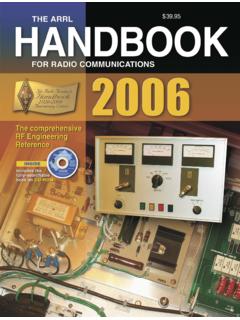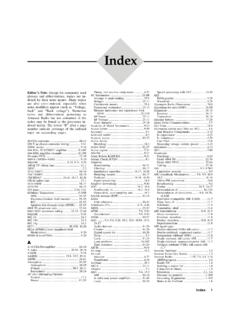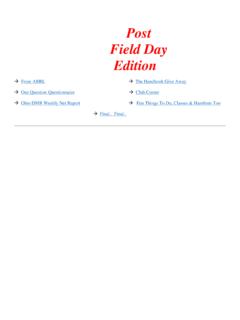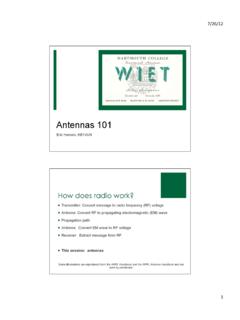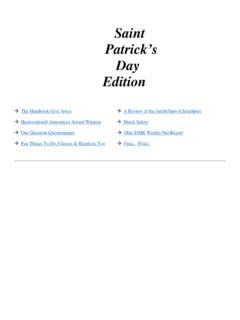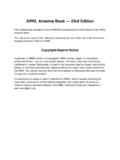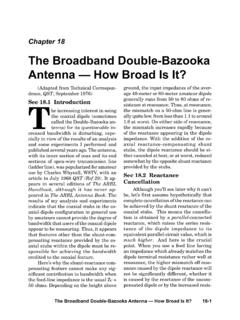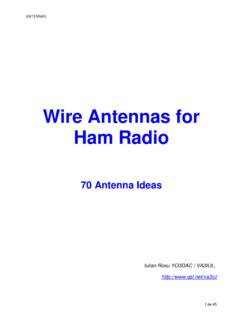Transcription of The ARRL Field Day Handbook - Androscoggin Amateur …
1 1 The ARRLF ield Day HandbookFor Radio Amateurs Production Michelle Bloom, WB1 ENT Jodi Morin, KA1 JPA David Pingree, N1 NAS Maty Weinberg, KB1 EIB AuthorSteve Ford, WB8 IMYC overSue Fagan, KB1 OKWC opyright 2010 by The American Radio Relay League, secured under the Pan-American ConventionInternational Copyright securedAll rights reserved. No part of this work may be reproduced in any form except by written permission of the publisher. All rights of translation are in the USAQ uedan reservados todos los derechosISBN10: 0-87259-088-7 ISBN13: 978-0-87259-088-5 First Edition2010 arrl Field Day Rules 9US Amateur Radio Band Chart 15 The Considerate Operator s Frequency Guide 16 arrl /RAC Section Abbreviations 17 arrl /RAC Section Map 18 Morse Code Character Set 19 Antenna Projects from the Pages of QST Having a Field Day with the Moxon Rectangle Cebik, W4 RNL 21 An Easily Constructed 30- and 40-Meter Trap Dipole Antenna Arthur Gillespie Jr, K4TP 26 A Simple HF-Portable Antenna Phil Salas, AD5X 27 A Ground Coupled Portable Antenna Robert Johns, W3 JIP 29 The NJQRP Squirt Joe Everhart, N2CX 34 Gain without Pain A Beam Antenna for Field Day Bob Clarke, N1RC 38 The Arkansas Catfish Dipole David G.
2 Byrd, KD7VA 42 A Three Element Lightweight Monobander for 14 MHz David Reid, PA3 HBB 44 A Simple Fixed Antenna for VHF/UHF Satellite Work Cebik, W4 RNL 48 A Portable 2-Element Triband Yagi Markus Hansen, VE7CA 52 A Portable Twin-Lead 20-Meter Dipole Rich Wadsworth, KF6 QKI 55 A One-Masted Sloop for 40, 20, 15 and 10 Meters Rick Rogers, KI8GX 57 One Stealthy Delta Steve Ford, WB8 IMY 60 A Horizontal Loop for 80-Meter DX John S. Belrose, VE2CV 62 ContentsTips for Field Day Power Power Packing for Emergencies John S. Raydo, K0IZ 69 Modern Portable Power Generators Small, Sleek and Super Stable! 72 Kirk Kleinschmidt, NT0 ZPublic Relations Press Release 77 Publicity Tip Sheet 78 Amateur Satellites Steve Ford, WB8 IMY 79HF Digital Communications Steve Ford, WB8 IMY 85 References RF Connectors and Transmission Lines 93 US Customary Units and Conversion Factors 99 Voltage-Power Conversion Table 101 Reflection Coefficient, Attenuation, SWR and Return Loss 102 Abbreviations 103 Antenna and Tower Safety 106 2010 Field Day Log 114 ForewordField Day is, without question, the largest on-air event in Amateur Radio.
3 Its roots are in the efforts of hams to exercise their emergency communication skills, starting with the first Field Day many decades ago. Emergency preparedness is still at the core of Field Day, although some also see it as a competition while others celebrate it as a social event. Since the beginning, Field Day has encompassed all of these things!Regardless of how you participate in Field Day, I believe you ll find this book to be a valuable reference. The antenna projects alone will spark your imagination. You ll also learn how to add to your Field Day point totals by making satellite contacts and using digital modes. Finally, this book includes a handy Field Day safe and have fun! 73, Dave Sumner, K1ZZ arrl Chief Executive Officer9 arrl Field Day 2010 Rules 1.
4 Eligibility: Field Day is open to all amateurs in the areas covered by the arrl /RAC Field Organizations and countries within IARU Region 2. DX stations residing in other regions may be contacted for credit, but are not eligible to submit entries. 2. Object: To work as many stations as possible on any and all Amateur bands (excluding the 60, 30, 17, and 12-meter bands) and in doing so to learn to operate in abnormal situations in less than optimal conditions. A premium is placed on developing skills to meet the challenges of emergency preparedness as well as to acquaint the general public with the capabilities of Amateur Radio. 3. Date and Time Period: Field Day is always the fourth full weekend of June, beginning at 1800 UTC Saturday and ending at 2100 UTC Sunday.
5 Field Day 2010 will be held June 26-27, 2010. Class A and B (see below) stations that do not begin setting up until 1800 UTC on Saturday may operate the entire 27-hour Field Day period. Stations who begin setting up before 1800 UTC Saturday may work only 24 consecutive hours, commencing when on-the-air operations begin. No Class A or B station may begin their set-up earlier than 1800 UTC on the Friday preceding the Field Day period. 4. Entry Categories: Field Day entries are classified according to the maximum number of simultaneouslytransmitted signals, followed by a designator indicating the nature of their individual or group participation. Twenty (20) transmitters maximum are eligible for the purpose of calculating bonus points (2,000 points maximum).
6 However, additional transmitters may be used simultaneously in determining your entry category. Switching and simulcasting devices are prohibited. Bonus stations, such as the GOTA station and satellite station do not count towards determining the number of transmitters for the class and do not qualify for transmitter bonus points. (Class A) Club / non-club portable: Club or a non-club group of three or more persons set up specifically for Field Day. Such stations must be located in places that are not regular station locations and must not use facilities installed for permanent station use, or use any structure installed permanently for Field Day. A single licensee or trustee for the entry is responsible for the group entry.
7 All equipment (including antennas) must lie within a circle whose diameter does not exceed 300 meters (1000 feet). To be listed as Class A, all contacts must be made with transmitter(s) and receiver(s) operating independent of commercial power mains. Entrants whom for any reason operate a transmitter or receiver from a commercial main for one or more contacts will be listed separately as Class A-Commercial. Get-On-The-Air (GOTA) Station. Any Class A (or F) entry whose transmitter classification is two or more transmitters may also operate one additional station without changing its base entry category, known as the GET-ON-THE-AIR (GOTA) station. This GOTA station may operate on any Field Day band, HF or VHF, but is limited to one transmitted signal at any time.
8 This station mustuse a different callsign from the primary Field Day station. The GOTA station must use the same callsign for the duration of the event regardless if operators change. The GOTA station uses the same exchange as its parent. The GOTA station may be operated by any person licensed since the previous year s Field Day, regardless of license class. It may also be operated by a generally inactive licensee. Non-licensed persons may participate under the direct supervision of an appropriate control operator. A list of operators and participants must be included on the required summary sheet to arrl HQ. As per FCC rules, this station must have a valid control operator present if operating beyond the license privileges of the participant using the station.
9 The maximum transmitter output power for the GOTA station shall be 150 the primary Field Day group is claiming the QRP multiplier level of 5, the maximum transmitter output power of the GOTA station may not exceed 5 watts. A maximum of 500 QSOs made by this station may be claimed for credit by its primary Field Day operation. In addition, bonus points may be earned by this station under rule The GOTA station may operate on any Field Day band. Only one transmitted signal is allowed from the GOTA station at any time. The GOTA station does not affect the additional VHF/UHF station provided for under Field Day Rule for Class A stations. Participants are reminded that non-licensed participants working under the direction of a valid control operator may only communicate with other W/VE stations or with stations in countries with which the US has entered a third-party agreement.
10 The GOTA station does not qualify as an additional transmitter when determining the number of transmitters eligible for the 100-point emergency power bonus under Rule Free VHF Station: Any Class A entry whose category is two or more transmitters may also operate one additional transmitter if it operates exclusively on any band or combination of bands above 50 MHz (VHF/UHF) without changing its basic entry classification. This station does not qualify for a 100-point bonus as an additional transmitter. This station may be operated for the clubs Field Day period and all contacts count for QSO credit. It is operated using the primary callsign and exchange of the main Field Day group and is separate and distinct from the GOTA station.

